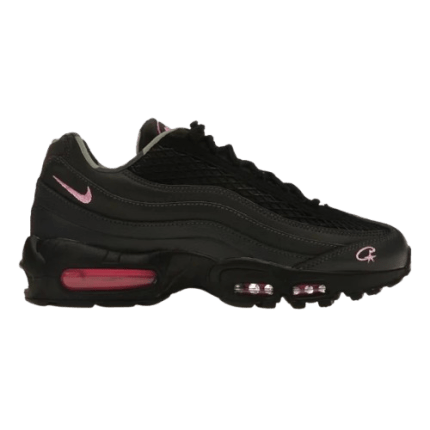When it comes to sneaker culture, few names carry the weight and legacy of Nike’s Air Max line. Among its most revered silhouettes are the Air Max 90 and the Air Max 95—two groundbreaking models that not only defined their respective eras but also remain enduring staples in streetwear and sports fashion. While both shoes fall under the same iconic umbrella, they offer distinctly different aesthetics, design philosophies, and cultural impact. Let’s take a closer look at what makes each of them unique and how they’ve shaped sneaker culture over the years.
Origins and Design Inspiration
The Air Max 90, originally released in 1990 and designed by Tinker Hatfield, was a follow-up to the Air Max 1. It pushed the limits of visible Air technology at the time and featured a more aggressive, sporty look. The original colorway—famously known as “Infrared”—highlighted the Air unit with bold accents, making the sneaker an instant classic. With its clean lines, panel layering, and vibrant color blocks, the Air Max 90 was designed to be fast, loud, and functional.
In contrast, the Air Max 95, designed by Sergio Lozano and released in—you guessed it—1995, took a radically different approach. Inspired by the human body, the design mimics anatomy: the midsole represents the spine, the layered upper symbolizes muscle fibers, and the lacing loops emulate ribs. Its gradient color scheme and unique wavy side panels were a bold departure from previous Air Max models. The 95 was also the first Air Max to feature visible Air units in both the heel and forefoot, making it a pioneer in performance cushioning.
Aesthetic Differences
Visually, these two sneakers speak different design languages. The Air Max 90 is sleek and structured, with a low-profile look that suits casual wear and classic street style. Its modular paneling makes it highly customizable and perfect for colorway experimentation, which Nike has taken full advantage of with hundreds of releases over the years.
The Air Max 95, on the other hand, is muscular and layered, giving it a more aggressive, futuristic appearance. Its signature gradient color fades and reflective accents give it a high-impact visual presence that stands out even today. The shoe also has a more technical feel, often favored by those who want a chunkier silhouette.
Performance and Comfort
Though both sneakers were initially designed for running, they have since transitioned into lifestyle footwear. That said, performance elements remain integral to their comfort and fit.
The Air Max 90 features a foam midsole with a visible Air-Sole unit in the heel, providing lightweight cushioning and impact absorption. It’s comfortable for all-day wear but retains a more traditional feel in terms of structure.
The Air Max 95 ups the ante with dual Air-Sole units in both the forefoot and heel. This gives it a more cushioned ride overall, especially for those who need extra support across the footbed. The 95 also introduced a new type of lace loop system that offers a snug, adaptive fit—ideal for more dynamic movements, though it’s primarily worn casually today.
Cultural Impact
Both models have earned legendary status, but their cultural footprints differ slightly.
The Air Max 90 has long been a favorite in mainstream fashion, often spotted on celebrities, musicians, and athletes. It’s a versatile silhouette that fits seamlessly into multiple style genres, from skate culture to hip-hop. The shoe has also been widely adopted in Europe and Asia, with unique regional colorways and collaborations further cementing its global appeal.
The Air Max 95, meanwhile, gained particular notoriety in urban centers like London and New York. In the UK, the 95 became deeply embedded in grime culture and was even nicknamed “110s” due to their original price tag of £110. Its edgier design and bolder profile made it a symbol of street authority and rebellious style. Over time, it’s maintained its “cult classic” status while enjoying periodic surges in mainstream popularity through collaborations and retro releases.
Collaborations and Limited Editions
Both sneakers have served as canvases for countless collaborations, with brands, designers, and artists putting their own spins on these classics.
The Air Max 90 has seen notable collabs with Off-White, Patta, DQM, and even NASA-inspired designs. Each reimagining has brought a fresh take to the silhouette while preserving its core identity.
The Air Max 95 has been equally prolific in collaborations. Commes des Garçons, atmos, Stüssy, and Carhartt have all created memorable editions. One standout is the atmos “Neon” colorway—a tribute to the original design that remains one of the most sought-after 95s ever.
Which One Should You Choose?
Choosing between the Air Max 90 and Air Max 95 ultimately depends on your personal style, comfort preference, and what you want your sneakers to say.
-
Go for the Air Max 90 if you like cleaner, more classic silhouettes with a strong nod to early ’90s style. It’s easy to wear with almost any outfit and offers dependable comfort.
-
Choose the Air Max 95 if you prefer bold, distinctive designs that make a statement. Its layered aesthetic and enhanced cushioning offer a unique blend of performance and edge.
Final Thoughts
The Air Max 90 and Air Max 95 are both monumental in their own right—each representing a specific moment in Nike’s evolution and sneaker culture at large. While one champions retro minimalism and versatility, the other pushes boundaries with anatomical design and technical innovation. Whether you’re a sneakerhead, a fashion lover, or simply someone looking for a comfortable pair of kicks, either model delivers iconic style and legendary status underfoot.












































